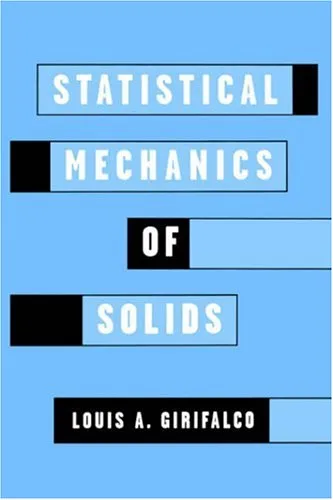Statistical Mechanics of Solids
4.3
Reviews from our users

You Can Ask your questions from this book's AI after Login
Each download or ask from book AI costs 2 points. To earn more free points, please visit the Points Guide Page and complete some valuable actions.Introduction to 'Statistical Mechanics of Solids'
Welcome to the world of statistical mechanics, where the complexities of solid-state physics are explored through the lens of thermodynamics and statistical methodologies. In 'Statistical Mechanics of Solids', I aim to provide a comprehensive foundation for understanding the physics of solids. This book serves as a bridge between statistical theories and the physical properties of materials, making it an essential resource for students, educators, and researchers alike.
This introduction provides a detailed overview of the book's objectives, organization, and core ideas. Below, I delve into a summary of the book's contents, key takeaways for readers, some notable quotes, and why this work is a valuable contribution to the field of statistical mechanics.
Detailed Summary of the Book
The book is structured to guide readers through the essential principles of statistical mechanics, with an emphasis on the behavior of solids.
Starting with a review of classical thermodynamics and statistical principles, the book introduces the essential tools physicists and engineers use to study material properties. It combines theoretical rigor and practical applications to explain phenomena such as heat capacity, mechanical strength, and electrical conductivity. These concepts are seamlessly integrated, offering a unified perspective on the underlying physical laws.
The book extensively covers important topics such as the statistical treatment of energy distributions, lattice dynamics, and phonons. Additionally, it investigates models like the Einstein and Debye theories of heat capacities, addressing how these approaches help model real-world behavior of crystalline solids. The section on imperfections in solids, including vacancies, dislocations, and other defects, is particularly impactful for researchers working on material performance and failure mechanisms.
Throughout the chapters, the applications of statistical mechanics are contextualized to address modern research areas such as nanotechnology, material design, and quantum phenomena in solids. By focusing on concepts such as entropy, free energy, and probability distributions, 'Statistical Mechanics of Solids' ensures the reader gains both a theoretical and practical appreciation of the subject matter.
Key Takeaways
The following are some of the most important lessons and insights readers will gain:
- A deep understanding of how thermodynamic and statistical principles govern the behavior of solids.
- Insights into lattice vibrations and the role of phonons in determining the heat capacities of solids.
- The ability to analyze materials at the atomic level, including the role of defects and imperfections.
- Mastery of statistical methods applied to predict mechanical, thermal, and electrical properties of solids.
- An appreciation for how statistical mechanics contributes to contemporary research in materials science and technology.
Famous Quotes from the Book
Within the book, several passages encapsulate the core philosophy of statistical mechanics and highlight its relevance to the study of solids:
"Statistical mechanics provides the bridge between the microscopic world of atoms and molecules and the macroscopic properties of materials."
"Understanding the imperfections in solids is not merely an academic exercise, but a key to harnessing their potential in the real world."
"In the realm of solids, disorder is not merely a deviation from perfection; it often holds the secret to astonishing properties."
Why This Book Matters
The significance of 'Statistical Mechanics of Solids' lies in its balance between theoretical depth and practical applicability. By connecting the microscopic characteristics of materials with their observable properties, this book equips readers with the tools needed to tackle real-world problems in materials science and engineering.
From understanding the dynamic behavior of crystals to analyzing the impact of atomic-scale defects on macroscopic properties, the book addresses both fundamental and applied aspects of statistical mechanics. Its treatment of classical and quantum systems is presented in a clear and systematic way, making complex topics accessible to a wide audience. Moreover, the text supports the development of critical-thinking skills, encouraging readers to challenge assumptions and apply concepts to evolving scientific and technological challenges.
The book’s importance extends beyond the classroom—its discussions of emerging fields such as nanotechnology and quantum materials underscore the enduring relevance of statistical mechanics in shaping the future of science and engineering.
For those seeking a deeper understanding of the physical world and a framework to explore the material universe, 'Statistical Mechanics of Solids' is a vital resource. Embark on this journey into the fascinating interplay of order, disorder, and the statistical laws that govern our world.
Free Direct Download
Get Free Access to Download this and other Thousands of Books (Join Now)
For read this book you need PDF Reader Software like Foxit Reader


